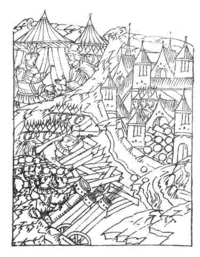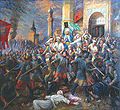- Siege of Kazan (1552)
-
Siege of Kazan Part of Russo-Kazan Wars
The illustration in chronicleDate September 2, 1552 – October 13, 1552 Location Kazan, Kazan Khanate, now Russia Result Decisive Russian victory, end of Kazan Khanate’s power Belligerents Tsardom of Russia
Qasim Khanate
Taw yağı 1Kazan Khanate
Cheremis and Ar warriors
Nogay cavalryCommanders and leaders Ivan IV of Russia
Alexander Gorbatyi-Shuisky
Andrey Kurbsky
ShahghaliYadegar Moxammat (POW)
Yapancha bak †
Zaynash morza (POW)
Qolsharif †Strength 150,000 men,
150 cannons
unknown battleship
some siege towers33,000 men2-
50,000, including civilians3
unknown cannonsCasualties and losses 15,3553-?
unknown wounded40,000–190,000 dead or missing (including civilians)3
more than 190,000 captured 3
many thousands displaced1Involvement disputed
2Tatar Encyclopaedia
3 Kazan Chronicle; it is likely that this source underestimates Russian and overstates Tatar casualtiesSuzdal – Vyatka – Kazan (1487) – Kazan (1506) – Moscow Protectorate – Kazan (1530) – Kazan (1545–50) – Sviyazhsk – Kazan (1552) – Kazan War (1552–56)
For other uses of "Battle of Kazan", see Battle of Kazan (disambiguation).The siege of Kazan in 1552 was the final battle of Russo-Kazan Wars. It led to the fall of Kazan Khanate. However, it was not the last battle on the khanate's territory. After the fall of Kazan, rebel governments formed in Çalım and Mişätamaq, and a new khan was invited from the Nogais. This continuation guerilla war was ended only in 1556.
Contents
The siege
The Russian forces included Streltsy as well as Moscow and Qasim irregular feudal cavalry, but the main role was played by Russian artillery and sappers, both Russian and foreigners. At first they were opposed by the Tatar garrison of Kazan, 10,000 Nogay horsemen led by the khan of Kazan, who originated from the Nogai Horde. Cheremiss units and Kazan irregular feudal cavalry were based in forests north and east of Kazan respectively. Their base was Archa stronghold. Before the battle Russians had a fortress on Volga, Ivangorod, later known as Sviyazhsk, some miles above Kazan. This wooden fortress was built in 1551 by Russian military engineer Ivan Vyrodkov, when after the conclusion of peace the right bank of Khanate (Taw yağı) passed to Russia. It would serve as a strong point for the capture of Kazan by the Muscovite army.
The 150,000 Muscovite army under Ivan IV came under Kazan's walls and besieged Kazan on August 22, 1552 (Old Style). Russian cannons shelled its walls from 29 August. Soon they smothered the fire of large-calibre Tatar cannons. During 30 August – 6 September Alexander Gorbatyi-Shuisky defeated the inner cavalry under Yapancha ad the Ar units and burned Archa. Andrey Kurbsky defeated Cheremis troops. Sappers blew up the underground way to Kazan's underground drinking water source.
A 12-metre high Siege tower (referred to also as a "battery-tower" to distinguish it from the pre-gunpowder siege engines) was built by Ivan Vyrodkov out of wood on site for mounting siege cannon. This revolutionary new design could hold ten large-calibre cannon and 50 lighter cannon, allowing a concentration of artillery fire on a section of the wooden wall or city, which played a crucial role in shattering Tatar resistance. However, it is certain that the few cannon defending Kazan would first have to have been put out of action in order for the tower to be effective, as it would otherwise have been an obvious target for any remaining artillery.[1]
On 2 October sappers (believed to have been led by Englishman Butler, also known as Rozmysl in Russian chronicles) blew up the wall near the Nogay and Atalıq Gates. Russian soldiers entered the city. The civil population as well as Kazan's army opposed them. After desperate slashing some survivors were blockaded in the citadel. Then, after khan Yadegar Moxammad and Nogai leader Zaynash were captured, the defenders of the citadel tried to escape to the northern forests, but they were defeated. 60,000–100,000 Russians who had been held captive in khanate were released.
Gallery
-
Qolsharif and his students defend their madrassa and the Cathedral Mosque.
See also
- Islam in Tatarstan
References and notes
Categories:- History of Tatarstan
- Conflicts in 1552
- 1552 in Russia
- Russo-Kazan Wars
- Sieges involving Russia
- 16th century in Russia
Wikimedia Foundation. 2010.




